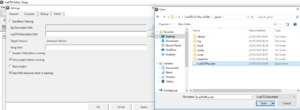Tutorial:Editor Sharp Installation
Jump to navigation
Jump to search
Upon downloading the sharp editor, place it in a root folder alongside the LuaSTG version you desire to use.

After that, open the Sharp editor (an error will pop-up, close it),

and select the LuaSTG executable.
After doing that, accept the changes and restart the editor.
After restarting the editor, go to the General settings and choose "LuaSTGXLib.Legacy.dll" as the plugin, save, and restart.
After restarting again, go to the same previous General tab, change back to "LuaSTGPlusLib.dll", then click on "Register Extention", save, and restart the editor.
After that, you can start using the editor (it's a weird way to make it work, but it works).
